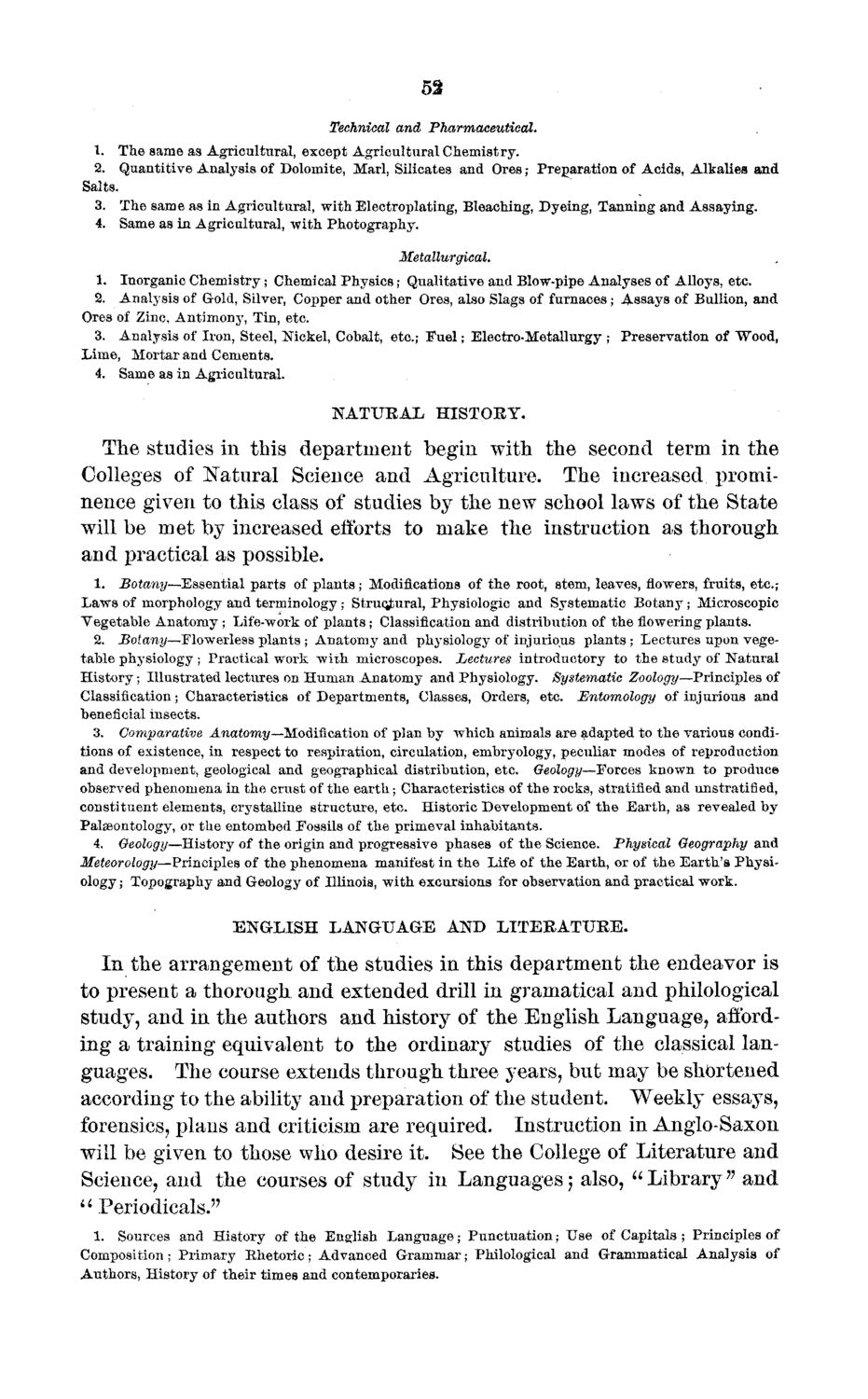| |
| |
Caption: Board of Trustees Minutes - 1873
This is a reduced-resolution page image for fast online browsing.

EXTRACTED TEXT FROM PAGE:
52 Technical and Pharmaceutical. 1. The same as Agricultural, except Agricultural Chemistry. 2. Quantitive Analysis of Dolomite, Marl, Silicates and Ores; Preparation of Acids, Alkalies and Salts. 3. The same as in Agricultural, with Electroplating, Bleaching, Dyeing, Tanning and Assaying. 4. Same as in Agricultural, with Photography. Metallurgical. 1. Inorganic Chemistry; Chemical Physics; Qualitative and Blow-pipe Analyses of Alloys, etc. 2. Analysis of Gold, Silver, Copper and other Ores, also Slags of furnaces ; Assays of Bullion, and Ores of Zinc, Antimonj', Tin, etc. 3. Analysis of Iron, Steel, Nickel, Cobalt, etc.; Fuel; Electro-Metallurgy ; Preservation of "Wood, Lime, Mortar and Cements. 4. Same as in Agricultural. NATURAL HISTORY. The studies in this department begin with the second term in the Colleges of Natural Science and Agriculture. The increased prominence given to this class of studies by the new school laws of the State will be met by increased efforts to make the instruction as thorough and practical as possible. 1. Botany—Essential parts of plants; Modifications of the root, stem, leaves, flowers, fruits, etc.; Laws of morphology and terminology ; Structural, Physiologic and Systematic Botany; Microscopic Vegetable Anatomy ; Life-work of plants; Classification and distribution of the flowering plants. 2. Botany—Flowerless plants ; Anatomy and physiology of injurious plants ; Lectures upon vegetable physiology ; Practical work with microscopes. Lectures introductory to the study of Natural History; Illustrated lectures on Human Anatomy and Physiology. Systematic Zoology—Principles of Classification; Characteristics of Departments, Classes, Orders, etc. Entomology of injurious and beneficial insects. 3. Comparative Anatomy—Modification of plan by which animals are adapted to the various conditions of existence, in respect to respiration, circulation, embryology, peculiar modes of reproduction and development, geological and geographical distribution, etc. Geology—Forces known to produce observed phenomena in the crust of the earth; Characteristics of the rocks, stratified and unstratified, constituent elements, crystalline structure, etc. Historic Development of the Earth, as revealed by Palaeontology, or the entombed Fossils of the primeval inhabitants. 4. Geology—History of the origin and progressive phases of the Science. Physical Geography and Meteorology—Principles of the phenomena manifest in the Life of the Earth, or of the Earth's Physiology ; Topography and Geology of Illinois, with excursions for observation and practical work. E N G L I S H L A N G U A G E AND LITERATURE. In the arrangement of the studies in this department the endeavor is to present a thorough and extended drill in gramatical and philological study, and in the authors and history of the English Language, affording a training equivalent to the ordinary studies of the classical languages. The course extends through three years, but may be shortened according to the ability and preparation of the student. Weekly essays, forensics, plans and criticism are required. Instruction in Anglo-Saxon will be given to those who desire it. See the College of Literature and Science, and the courses of study in Languages) also, " Library ?? and u Periodicals." 1. Sources and History of the English Language; Punctuation; Use of Capitals ; Principles of Composition; Primary Rhetoric; Advanced Grammar; Philological and Grammatical Analysis of Authors, History of their times and contemporaries.
| |